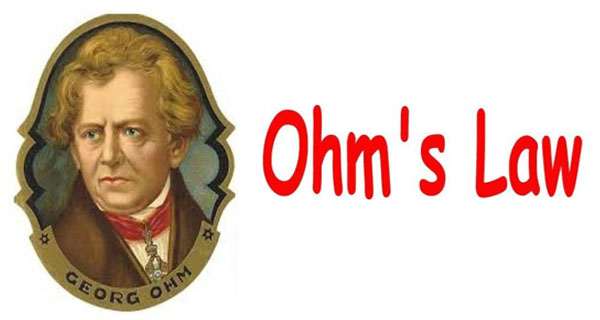Ohm’s law is all about current and voltage and the relation between the two. How current and voltage are inter related is stated and defined in this law. Ohm’s law has many complex forms such as the Ohm’s acoustic law, however, this the simple form has proved to be helpful in numerous ways, some of which have been listed below. Ohm’s law incorporates a constant in it as well which is represented by R and defined as ‘’Resistance’’.
The basic definition of Ohm’s law is that,
‘’Current passing through a conductor between two points is directly proportional to the voltage’’
And to make both the sides equivalent to one another, one can use the constant R or resistance.
Current is dependent upon a number of different factors but the most obvious ones are voltage and resistance. How they are related to one another has been given by the equation.
MATHEMATICAL FORM OF OHM’S LAW AND UNITS:
All the values incorporated in the equation are in their ‘’standard’’ forms and therefore the standard or SI units are used.
Ohm’s law can be mathematically stated as well. V=IR – In terms of voltage
I=V/R – In terms of current
R = V/I – To find the constant
where I is current, V is voltage, and R is resistance. The current is in Amperes, Voltage in volts and R is actually expressed in terms of a unit called, ‘’Ohm’’.
Ohm’s law is further related to the ‘’current’’ density as well and can by making it more complex and making a few amendments. However, this must also be understood that resistance is the force, which opposes the passing or movement of charges or the flow of electric current due to which, it is inversely related to the current. The antonym for resistance is, as many might expect, electrical conductance or conductivity.
IMPORTANCE OF OHM’S LAW:
Coming to the importance, Ohm’s Law is probably known as the most vital and important relationship between current and voltage. This law is easy to understand and state and does not involve much complex explanations (The general form).
-Ohm’s law can be used to calculate Voltage, if current and resistance are known.
-It can be used to calculate Current (I), If voltage and resistance are known.
-It can be used to calculate Resistance R, If current and voltage are known.
So, if any two quantities are known, the third can easily be calculated with this law.
Moreover, the law tells us how both the quantities vary with respect to one another. Which means, it shows how increasing one quantity can affect the second quantity if the one of the three is kept constant. On the daily basis, when circuits are designed or brought into function, Ohm’s law is used mainly to know about the resistance.
As science has developed and has passed through numerous folds, there have been developed many electrical devices to calculate current and voltage. So this law is mainly and commonly used to calculate how much resistance the circuit would offer if some Amperes of current is passed through it such that voltage is kept constant or varies.
Many fields such as ‘’electrical engineering’’ are concerned with the use and the applications of Ohm’s law.
We use many such appliances in our daily lives that involve the use of this law. For example, we have this electrical heater present at almost every house around the globe which is used to provide heating. If we want to know how much power is being applied to the electrical heater, we can easily do this by the help of an Ohm’s calculator which works purely on Ohm’s law.
When houses are designed and there has to be the decision of the fuses, Ohm’s law is brought into action and use. It helps know all about the resistance, power and voltage in order to provide a safe electrical supply to the house.
Read : The greatness of Abdul Kalam : Surprise to Know !
OHM’S LAW CALCULATOR:
It might be surprising to some, but yes, an Ohm’s law calculator also exists. Now OHM’S LAW CALCULATOR helps you find all the three things which are involved in your Ohm’s law. i.e. voltage, resistance, and also current. The calculator requires the three basic things. It is very easy to use and helps calculate the desired value within seconds. Given below is the basic interface of the calculator. Which will provide a good idea of how the calculator is used and what its requirements are.

Now as can be seen from the picture above, the calculator is able to calculate voltage in the first row. Given that current in Ampere and resistance in ohm’s are provided.
– In the second row, the calculator is able to calculate current.! Provided that, resistance and voltage are given. And they are in their SI units.
-In the third and final row, resistance can be calculated with the help of voltage . Current which are in volts and amperes respectively.
Taking an example of how to calculate any ‘’one’’ of the given, we can suppose the quantities and easily calculate the third one. (Refer to the screenshot below).

Now if a supposition is taken, that a circuit offers 22 ohms of resistance and 33 volts of voltage. Then the resultant current will be round about 0.13 amperes. Which has been shown above. Moreover, if we decrease the resistance.! The current shows an increase (even if it is a slight one) thus satisfying Ohm’s law.

Hence, this satisfies the ohm’s law equation. As the resistance is decrease to 19 from 22 ohms, the current has shown an enormous increase.




